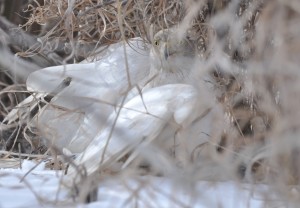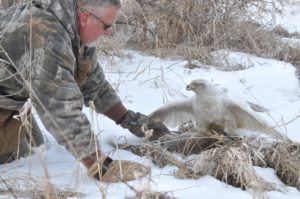Photography courtesy of Lowell Washburn, all rights reserved.
With piercing yellow eyes and ghostly white plumage, the Siberian goshawk is one of the planet’s most stunningly beautiful raptors. As large — or sometimes even larger — than an American red-tail, it is one of the world’s most efficient winged predators. Inhabiting one of the harshest climates on earth, the bird is seldom observed by humans and you definitely won’t spot one cruising the Iowa woodlands. That is, unless you happen to cross trails with Spirit Lake’s Ross Dirks.
As owner of the Dickenson County Animal Clinic, Dirks has been involved in numerous wildlife conservation projects including Iowa’s peregrine falcon restoration and trumpeter swan recovery. A talented master falconer, Ross is currently flying a captive bred Siberian goshawk. The hawk is a direct descendant of stock originally imported from eastern Russia by Lance Christensen and Vic Hartiswick. [It’s hard to say which feat is more incredible: that wild trapped Siberian goshawks were successfully imported to the mid-west or that the birds actually bred in captivity.] At any rate, the white goshawks are one of the rarest species to be used in falconry — anywhere.
My first opportunity to observe the bird in action came this week when Dirks and I met up for a day of hawking in North Central Iowa. Davenport falconer, Tom Deckert completed our ‘Three Amigos Hunting Party’.
Earlier this season, the white goshawk racked up a remarkable score of pheasants and mallard ducks. On this outing, however, the focus would be on cottontail rabbits. To find them, we would need to beat the thickest brush filled habitats the countryside had to offer.
Arriving at an overgrown woodlot, Ross quickly released his white ‘gos. The hawk flew to the branches of a large cottonwood and the hunt began. The results were nearly immediate. We had barely walked for three or four minutes when Deckert flushed the first rabbit. The hawk gave chase and following some fancy maneuvering, pinned the cottontail to the snow. After feeding the bird a partial meal, Ross put the rabbit in his game bag and the hunt resumed.
Ten minutes later, we moved another rabbit that immediately dove into cover so dense that we could only catch occasional glimpses of fur as the animal blasted past. The white ’gos made its move, meeting the fleeing rabbit head on. The raptor spotted a hole in the cover and although the opening was only about half the size of a basketball, it was enough for the hawk to reach through and connect.
As the goshawk firmly anchored its prize it suddenly occurred to me that somewhere in the span of just fifteen minutes, the hawk had secured enough wild game to provide itself as well as our three man hunting party with a cottontail dinner. Helps explain how the birds manage to survive in one of the most remote and harshest regions to be found anywhere on earth.




 Susan Judkins Josten
Susan Judkins Josten Rudi Roeslein
Rudi Roeslein Elyssa McFarland
Elyssa McFarland Mark Langgin
Mark Langgin Adam Janke
Adam Janke Joe Henry
Joe Henry Sue Wilkinson
Sue Wilkinson Tom Cope
Tom Cope Kristin Ashenbrenner
Kristin Ashenbrenner Joe Wilkinson
Joe Wilkinson Dr. Tammy Mildenstein
Dr. Tammy Mildenstein Sean McMahon
Sean McMahon